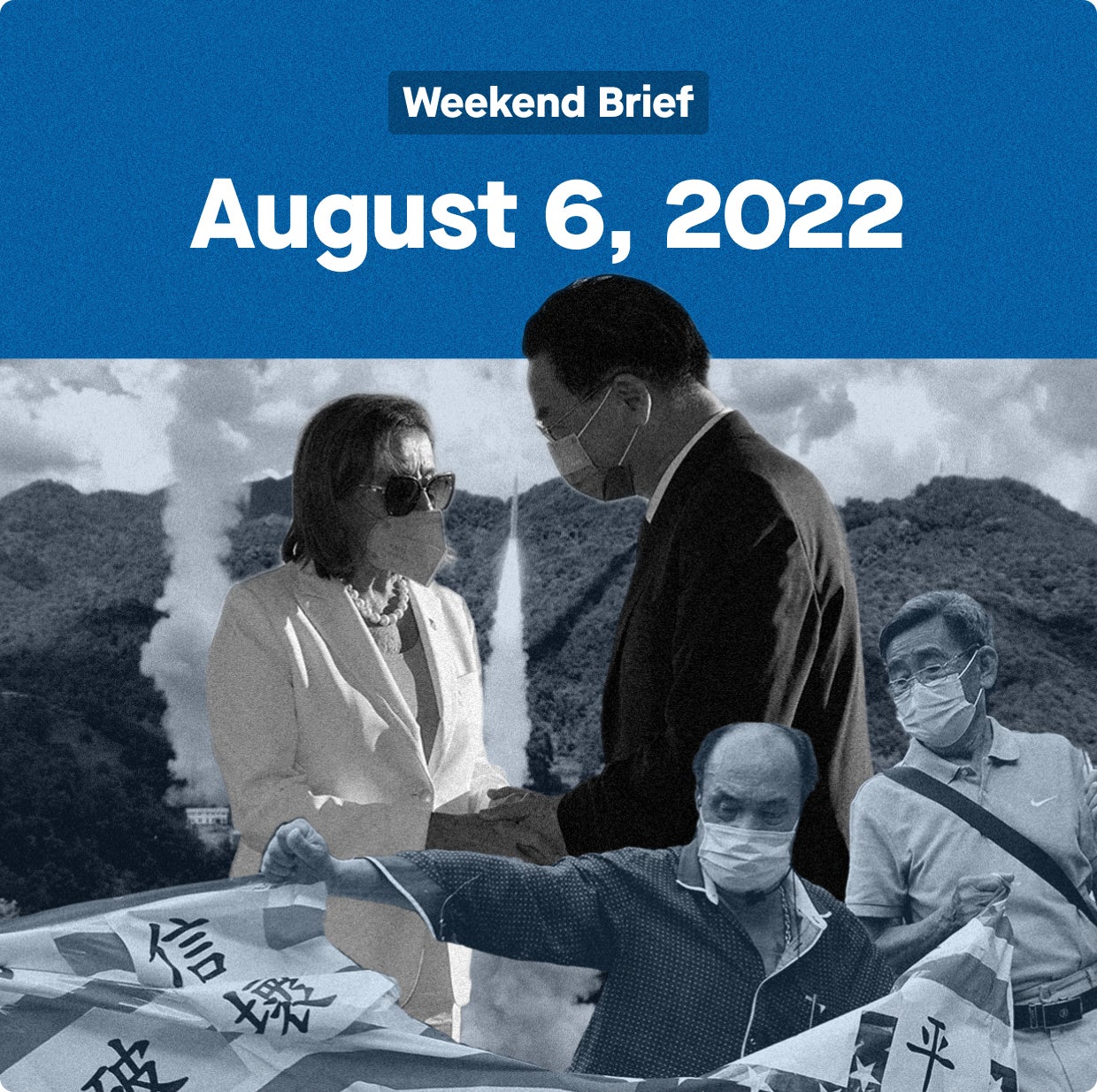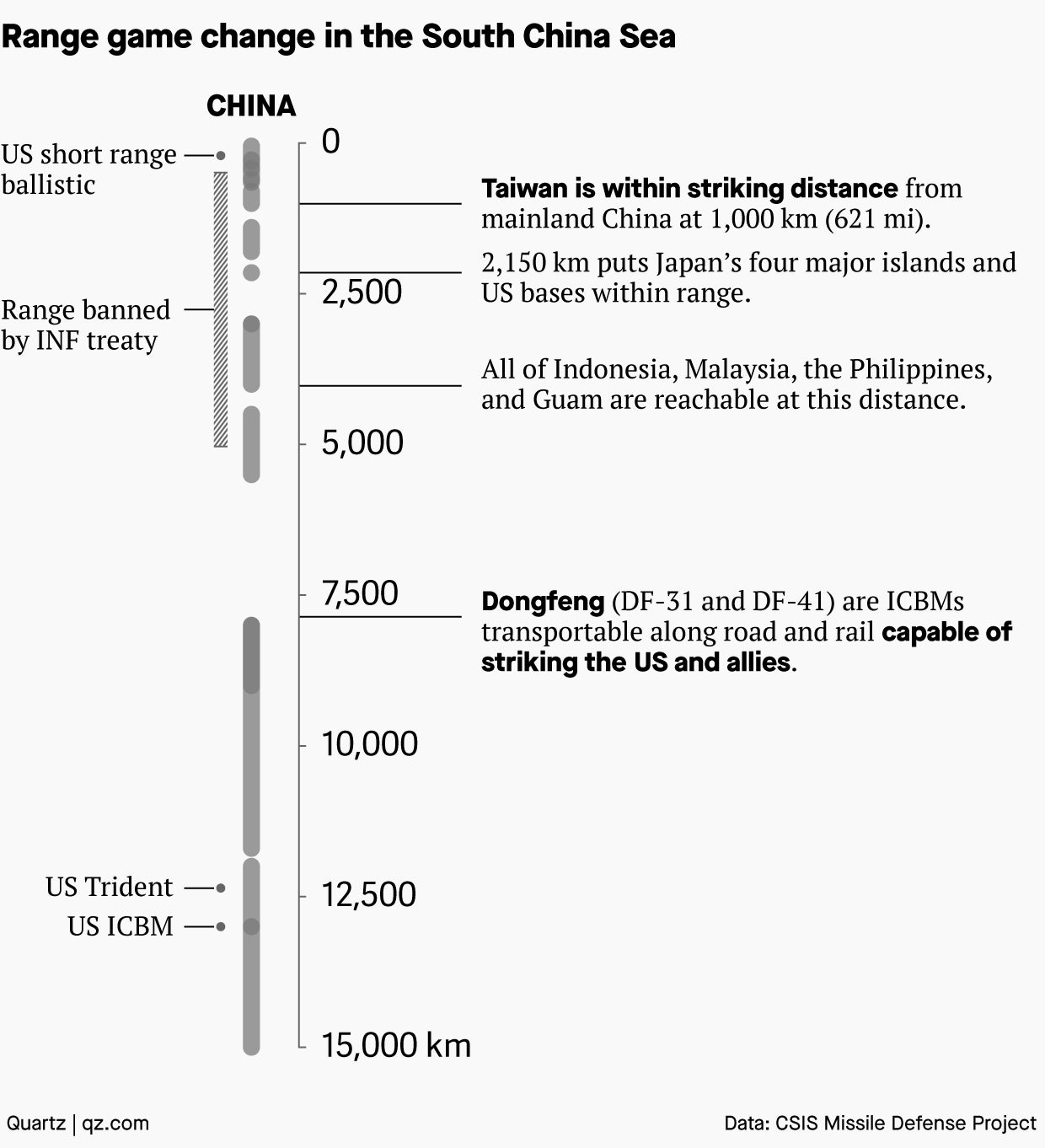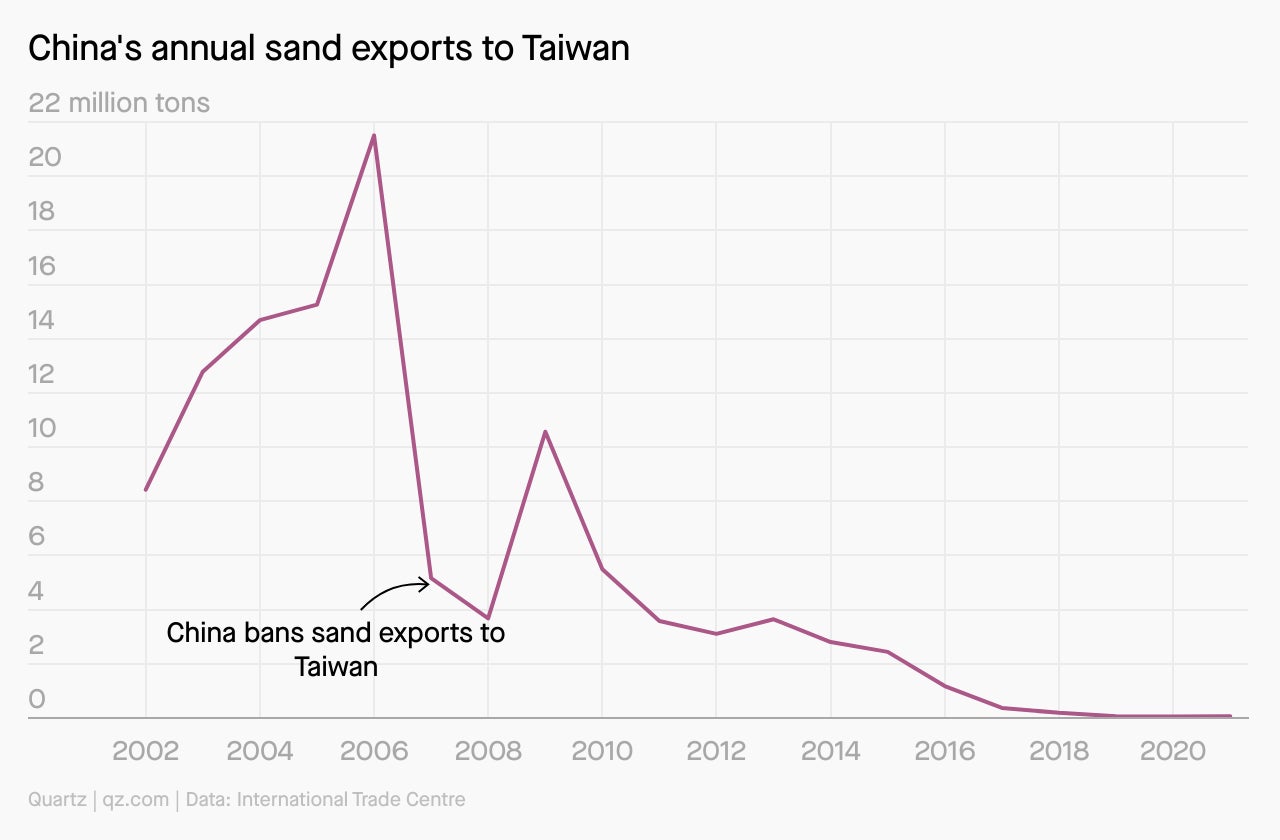The trouble over Taiwan
If US-China tensions in the South China Sea escalate, the fallout will hobble every economy in the world.


Hi Quartz members,
It takes a lot to force a war out of the headlines. The prospect of an even bigger war will do it, though.
On Aug. 2, when Nancy Pelosi, the US Speaker of the House, visited Taiwan, every eye turned towards the South China Sea. (Even Russian state media and diplomats talked more about China and Taiwan than they did about Ukraine.) Reactions from China were swift: a bevy of sanctions against Taiwan; a halt on defense and climate talks with the US; and perhaps most worryingly, warships and missiles sent into Taiwanese waters.
An escalation of these tensions into a war in the South China Sea is still unlikely–but its potential fallout is so horrific, in both human and economic terms, that it needs contemplation. Hundreds of millions of people live within striking distance from China; it isn’t just Taiwan that needs to worry, as Japan discovered when five Chinese missiles landed in the ocean near Okinawa on Aug. 4.

And if sanctions on Russian energy have roiled the economy, that level of chaos will only pale before a campaign to isolate China–or a Chinese campaign to isolate itself. A RAND Corporation report (pdf) estimated that a one-year war between the US and China would cut 5-10% off US GDP–and 25-35% off Chinese GDP. Foreign demand makes up around 15% of China’s GDP; if other economies have to stop buying from China in the midst of a war, its citizens would face a long and difficult depression.
Other countries would get shot up in the cross-fire as well. Supplies of manufactured goods out of China will seize up; two-thirds of Chinese exports go to nations aligned with the US. Exports of rare earth metals and Taiwanese semiconductors, the hearts of all our modern digital devices, will grind to a near-halt. It has been hard enough finding immediate replacements for Russian oil and gas. Finding immediate replacements for everything China offers to the world economy–a giant market, labor force, and pool of factories rolled into one–will be impossible.
THE BACKSTORY
The video is grainy, but the steely voice is unmistakable. It is 1991, and Nancy Pelosi, as part of a small American delegation, is at Tiananmen Square to honor the pro-democracy activists who’d died two years earlier. She holds up flowers and a banner, until police hustle her and her colleagues away. “Tiananmen Square is a magnet for us,” she said. “There is no way we could come here without being drawn to the square.”
Pelosi’s visit to Taiwan this past week is only the most recent episode in her decades of confrontations with China. She has hobnobbed with the Dalai Lama, pressed Chinese leaders to release political dissidents from prison, called for boycotts of sporting events in China, and welcomed Hong Kong activists into the US Capitol. To China, each of these counted as a deliberate poke in the eye.
Remarkably, Pelosi’s stance stayed firm even as the US grew more and more reliant on trade and investment links with China. (“If you cannot stand up for human rights in China because of commercial interests, you lose all moral authority to speak out for it in any place,” she said recently.) But the ultimate rupture came on Aug. 5, when China levied unspecified sanctions on Pelosi personally, making her the highest-ranking US official ever penalized by Beijing.
THE SAND TRAP
Among China’s retaliations against Taiwan, in the wake of Pelosi’s trip, was a strange one: a ban on sand exports to Taiwan.
Sand—a key ingredient in the glass, concrete, mortars, and plasters used in many construction projects—has emerged as a small but contentious flashpoint in cross-strait relations. Taiwan used to import much of its sand from China; at one point, around 15 years ago, nearly 80% of all its sand imports came from China. But in recent years, Taiwan has been working to wean itself off Chinese sand, so that the construction of new homes, office towers, and factories isn’t at the mercy of Beijing’s export policy.

The sand trade itself is little more than a blip in the Chinese and Taiwanese economies. But its knock-on effects on construction could make the ban more disruptive: When Taiwan faced a sand and gravel shortage in 2019, government ministers scrambled to bolster domestic supply to avoid delays in the estimated 30,000 construction projects that break ground on the island each year. At the very least, banning sand exports gives Beijing a symbolic way to lash out at the Taiwanese construction industry, at a moment when it is busy building $120 billion worth of new semiconductor factories that Taipei hopes will secure the island’s economic future and cement its status as an irreplaceable trade partner to the US and its western allies.
What to watch for next
- A Taiwan blockade. After Pelosi’s visit, the Chinese military instituted a temporary marine blockade around Taiwan for the very first time, strangling sea lanes to and from the island. It was intended to serve as both warning and proof that a more comprehensive blockade could follow.
- More warplanes. The Global Times, the Chinese Communist Party’s newspaper, has recommended dispatching a fighter jet right across Taiwan. It would be an extreme provocation, even though Chinese military planes already routinely flit in and out of Taiwan’s larger air defense space.
- Shipping disruptions. The South China Sea is a highway for a full third of global maritime trade (pdf), according to the UN. Even a big escalation of tensions, let alone a full-fledged war, will disrupt shipping massively–at a time when the world has spent nearly two years coping with supply chain problems.
- Semiconductor shortages. Another problem already plaguing the global economy–the shortage of microchips–will become more dire if Taiwan isn’t able to trade. More than 90% of the most advanced semiconductor chips are manufactured in Taiwan; if these chip foundries fall under Chinese control, or are affected in any other way, it would result in an economic earthquake.
- Urgent diplomacy. In theory, both the US and China have too much to lose from a hot war, a cold war, or even a trade war. China’s military aggression and sanctions over the last few days may be intended only to remind the US and Taiwan not to disturb the status quo too far. But it can prompt diplomats behind the scenes to calm the waters on both sides.
One ✈️ thing
Through much of her tour of Asia, Nancy Pelosi’s visit to Taiwan was speculative. Will she? Won’t she? So when her flight took off from Kuala Lumpur and headed north, hundreds of thousands of people logged onto FlightRadar24 to see where she was headed. Pelosi’s Boeing C-40C jet, the US Air Force’s version of the 737, took seven hours to make the flight. Around 2.9 million people followed at least a part of that journey on its web site, making it the most-tracked flight in FlightRadar24’s history. Its servers were so strained that access to the website was temporarily restricted–a high point for popular interest in both aviation and Asian geopolitics.
Quartz stories to spark conversation
- Tupac’s estate is in a fight over an iconic album cover and its NFT
- UPS drivers are collapsing from heat exhaustion—and bringing it to the bargaining table
- One of the world’s top floral designers takes stock of the trends reshaping his trade
- Balenciaga is trying to sell you a $1,790 trash bag
- Who should Elon Musk be afraid of?
- Despite fewer job openings, Americans keep quitting at record rates
5 great stories from elsewhere
🔥 Playing with fire. On a recent diplomatic call between Xi Jinping and Joe Biden, the Chinese president stated: “Those who play with fire will perish by it.” That fire is now burning hotter following Nancy Pelosi’s visit to Taiwan this past week. This kind of visit is not unprecedented, writes Foreign Affairs, but we have also entered a new era in cross-strait relations, and the US would do well to tread carefully.
⚡ Can’t touch this. Pelosi’s visit to Taiwan stoked the fury of Beijing, triggering a Chinese ban on over 100 brands. But Taiwan’s chip industry, the largest in the world, has been left unsanctioned. Al Jazeera explains why the island’s semiconductor sector not only makes it strategically important to western nations, but also to China, which accounts for 60% of global chip demand.
👂 The sound of silence. Electric vehicles are basically inaudible, posing dangers to unaware members of the public. Enter the world of acoustic design for automobiles, a field that combines the technical skills of sound design with the artistic sensibility of a perfumer. The New Yorker introduces us to the composers, musicians, and creative sound directors who are being hired to imagine what EVs, and by extension urban landscapes, should sound like.
🤒 Long covid blues. An estimated one in 13 people have contracted severe cases of covid, and of those, about one in five are experiencing long covid symptoms. Now Facebook and Reddit communities are popping up to provide support and advice. In an interview with Culture Study, Katy Pearce, a professor at the University of Washington, talks about the themes, gender dynamics, and questions circulating in these online forums, and what they reveal about the understanding of care for disabilities and health issues.
👑 Queen Bey is back. Grab your headphones and turn up the volume, because Beyoncé has returned with her seventh album Renaissance. A review from Pitchfork breaks down “Act 1” in the three-part musical release, which is chock full of samples and references to Black pop music and history. For those long cooped-up during the pandemic, the stripped-back, clubby dancefloor tracks are a welcome release.
We’d love your feedback on Quartz’s membership, because we’re always looking for ways to improve and make the experience better for you. Please let us know your thoughts in this brief survey–three minutes or less, we promise! The survey is here. Thank you, in advance, and thank you for reading!
Have a strife-free weekend,
—Samanth Subramanian, global news editor, and Nicolas Rivero, tech reporter
Additional contributions by Julia Malleck, Alex Citrin-Safadi, Daniel Wolfe, and Tim Fernholz.